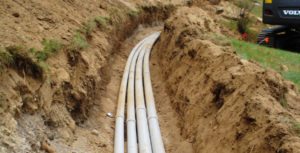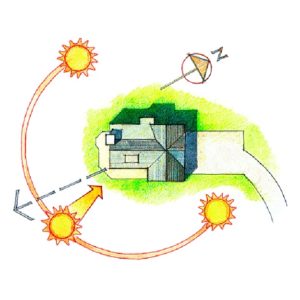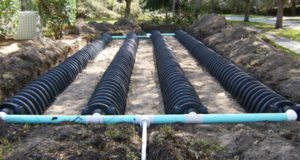Often due to a lot of factors—including your builder’s schedule, building permit restrictions or just plain timing—construction on your new Katahdin Log Home won’t begin until springtime. If you’re raring to get going on spring building, there are several tasks you can accomplish over the winter months that will put your home’s construction on the fast-track in April.
- Selective Cutting
Most land parcels have some undesirable tree growth, even if it’s just saplings and brush. The colder months are a perfect time to go in and clear trees you don’t want and mark trees you want to preserve. If your site is well-forested, a local state forester may be available to walk the property and assess the overall health of your woodlot. Larger trees may need to be harvested so that newer growth can thrive.
Your building envelope may need to be cleared so that construction can proceed unhampered. If your building site is located a distance from the road, a pathway for road and driveway access will also need to be cut. Coordinate with your contractor or paving subcontractor so that the path is clear and the right trees are taken. Depending on the site and the trees, the value of the lumber may be used to offset tree removal costs. You may also want to identify some good hardwood specimens to cut and incorporate into your new home.
2. Get Started on Infrastructure
Road Access— As noted above, trees may need to be removed to clear a pathway for your access road. Because your Katahdin home will be arriving on large semi flatbeds, having your access road ready will be an important step to getting your construction going in the spring. Some components of your road access to consider are water flow, terrain, soils, and road materials.
Utilities — Take note of the utilities you plan to have servicing your new home. They might include  electric, telephone, cable internet/television. Another decision is whether to install these utilities above or below ground. Many factors can impact the decision of utility placement, including local weather, distance from the trunk lines, costs of utility poles, soil composition, preferences and cost. If you’re building in a northern state where winters can produce some fierce storms, opting for underground may be the best solution for uninterrupted service. Exploring the options and getting cost estimates are great tasks to prepare in the winter months.
electric, telephone, cable internet/television. Another decision is whether to install these utilities above or below ground. Many factors can impact the decision of utility placement, including local weather, distance from the trunk lines, costs of utility poles, soil composition, preferences and cost. If you’re building in a northern state where winters can produce some fierce storms, opting for underground may be the best solution for uninterrupted service. Exploring the options and getting cost estimates are great tasks to prepare in the winter months.
3. Siting-in the Envelope Many months may have passed between the purchase of your land and the finalization of your log home plans. As a part of your spring building prep, it’s a good idea to stake out the house corners and check if you’re siting your home to maximize your setting.
Setbacks — A quick visit to your town hall can verify the setback requirements for front, rear and side boundaries. If your property includes shoreline or wetlands, it may be time to get an expert in  to fully define where you can safely build.
to fully define where you can safely build.
Orientation— How your home is oriented by points on the compass can affect the performance and enjoyment of your home. Orientation can affect the window selection, solar power options, passive solar benefits among other factors. It’s easier to rotate your plans than to compensate for a bad angle to the sun. Consider the function of parts of your home relative to sunlight. Eastern facing bedrooms will be lit at sunrise; westerly facing kitchens will get strong sunlight at dinnertime.
Lines of sight & scenery — If you’re making beautiful views an essential part of your log home, make sure your home is facing the right way for the view you envision. Making sure your garage doesn’t block your master balcony lake view will save a disappointing outcome.
 4. Well and Septic— If you’re waiting for a permit in a community with limited building, many towns will allow some of the construction as long as it is below a certain threshold of the total construction project. Wells and septic are good spring building prep projects for winter months. Wells can be drilled nearly any time of year, and you may find prices are lower in the off season for well companies looking to keep crews busy. Private septic disposal systems can also be worked on so that they’re ready for hook up when the house is complete. If you do these pre-construction projects, make sure that the plumbing and electrical are completely connected later in the process, especially if your subcontractors are different from the contractor’s team.
4. Well and Septic— If you’re waiting for a permit in a community with limited building, many towns will allow some of the construction as long as it is below a certain threshold of the total construction project. Wells and septic are good spring building prep projects for winter months. Wells can be drilled nearly any time of year, and you may find prices are lower in the off season for well companies looking to keep crews busy. Private septic disposal systems can also be worked on so that they’re ready for hook up when the house is complete. If you do these pre-construction projects, make sure that the plumbing and electrical are completely connected later in the process, especially if your subcontractors are different from the contractor’s team.
Foundation Work — Again, off season work on construction of foundations, slabs and other concrete work can be a money-saver by hiring foundation crews and concrete trucks to complete this work during the winter months. Make sure your foundation contractor has experience with cold-weather foundation construction to avoid problems with temperature changes.
Plan Your Kitchen — Winter offers a great time to research appliances, work with a kitchen designer and ensure that appropriate wiring, plumbing, gas lines and other structural requirements are included in your plans. If you know what types of appliances you desire, buying them together during traditional sale times can save you some serious money.
Review plans with an efficiency consultant — Obtaining a positive efficiency rating for your home can allay any lingering questions about the overall home performance, and add to a resale bottom line in the future. Efficiency consultants can review plans and conduct on-site inspections to make sure that your log home’s efficiency reaches its potential. Sometimes a separate set of eyes will see something that needs a remedy that’s easier to accomplish before construction is complete. The final step should be a blower door test and report that proves your home’s performance. Several types of efficiency programs are out there: Energy Star, RESnet and LEED are among the most popular.
